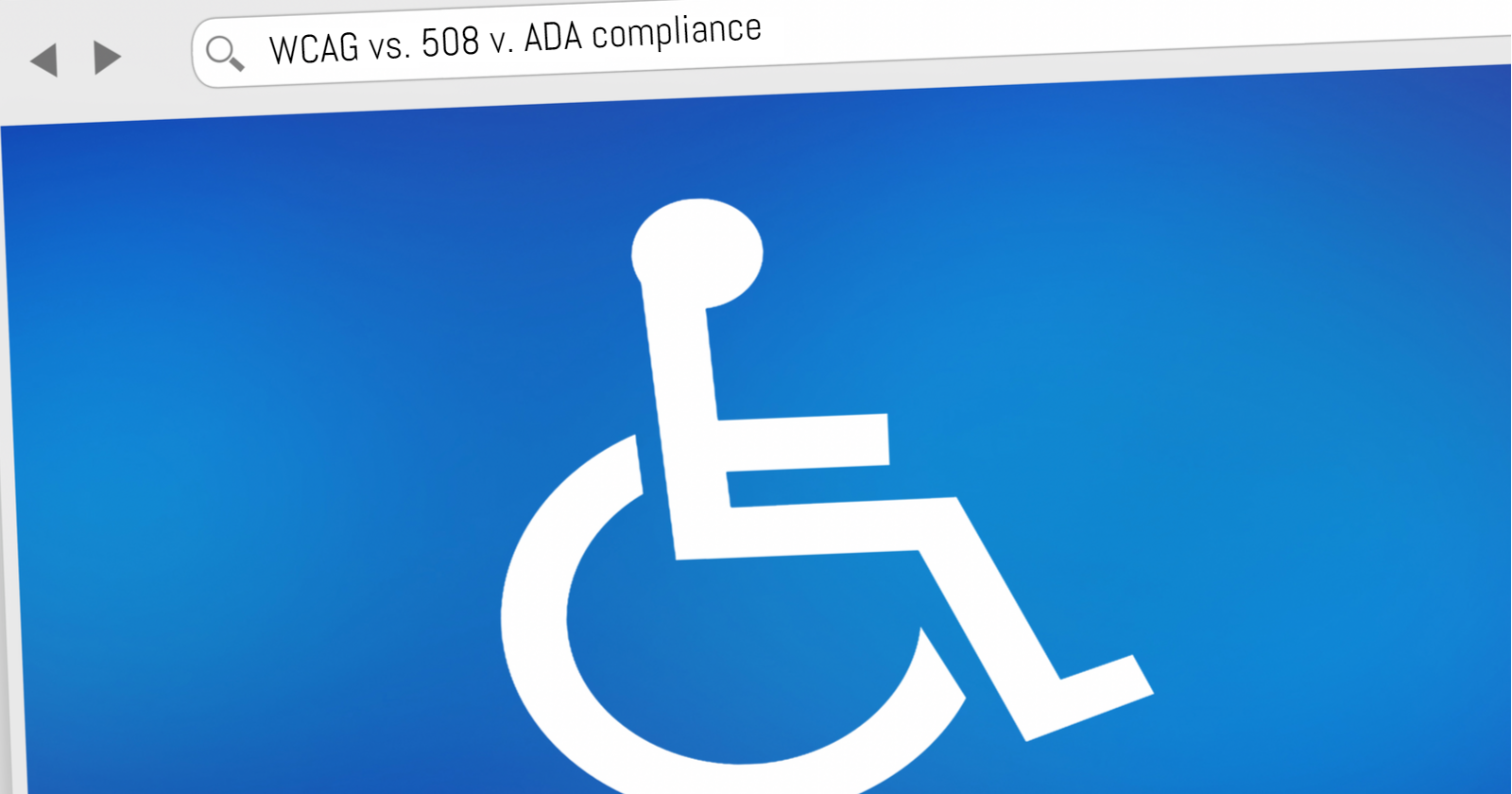Website accessibility lawsuits in the United States are becoming more common.
In fact, industry analysts note that the number of web accessibility lawsuits has grown 19.8% this year and that retailers account for 73.7% of digital accessibility lawsuits.
Some of the suits attempt to extort small businesses, but other cases have led to penalties against business owners.
Creating or updating a site to reach the point of accessibility must be a priority for site owners.
Knowing and understanding WCAG, 508, and ADA compliance is a good start when making your site as accessible as possible.
WCAG vs. 508 vs. ADA: Get to Know Key Website Compliance Standards
Website compliance standards are relatively new; at the very least, enforcement of these standards is just beginning to impact site owners.
There are three main types of compliance standards that you can follow:
- Americans with Disabilities Act (ADA).
- Web Content Accessibility Guidelines (WCAG).
- Section 508, the U.S. General Service Administration’s Government-wide IT Accessibility Program (referred to as 508).
If you’re found to violate ADA compliance, your first violation may result in a penalty of $55,000 to $75,000. Subsequent violations can result in a $150,000 fine.
However, there are different requirements of each standard that web developers and site owners need to know.
ADA Basics
Website accessibility is found under Chapter 5, Title II of the legislation and applies to governments, nonprofit organizations, and businesses.
Even if your site doesn’t fall within these categories, it’s recommended that you try and make your website accessible.
Businesses with federal funding may lose their funding if their site isn’t accessible.
Legal liabilities are also a concern and something to consider, too.
One main issue is that there are no clear guidelines to meet ADA compliance. The main guideline is to accommodate users with disabilities.
Compliance has been enforced in court, as seen under the Winn-Dixie supermarket lawsuit.
As a business owner, it’s essential to do one of two things:
- Take steps to offer an accessible website.
- Make a “good-faith effort” to accommodate all website users.
WCAG recommendations are what most businesses use to make their website as accessible to users as possible. We’ll dig into that in the next section.
If you’d like to learn more about ADA compliance don’t miss these excellent resources from Kim Krause Berg:
- Website Accessibility & the Law: Why Your Website Must Be Compliant
- A Beginner’s Guide to ADA Website Accessibility Compliance
WCAG Basics
Web Content Accessibility Guidelines (WCAG) are clearly defined and a good standard to make the web accessible. In addition, W3C offers developers guidance for different levels of accessibility designated by: Level A, Level AA, and Level AAA.
Achieving Level AAA means every user, despite their disability, can use and view the site to its fullest extent.
It’s essential to know a few things about WCAG standards:
- These standards can help make your site ADA compliant.
- WCAG is not the law.
Web developers can follow the recommendation in the WCAG guidelines using the Quick Reference that will help develop a site that is more accessible.
Among other things, WCAG recommends that your site demonstrate the qualities below.
Perceivable
- Non-text content should include text alternatives.
- Offer captions or other alternatives for your multimedia content.
- Create content that assistive technologies can understand.
- Make font sizes, images, and multimedia easy to see and hear.
Operable
- Offer keyboard accessible options.
- Allow for enough time, or pausing, of multimedia.
- Limit or eliminate flashing.
- Create straightforward navigation and pages that are navigable.
Understandable
- Offer readable, legible text.
- Make content operate and appear in a predictable way.
- Make it easy for users to avoid and/or correct mistakes.
- These are a few of the recommendations that need to be followed under the 508 compliance.
508 Basics
Are you a federal agency? If not, 508 compliance probably doesn’t apply to you.
According to Section508.gov:
“The law (29 U.S.C § 794 (d)) applies to all Federal agencies when they develop, procure, maintain, or use electronic and information technology.
Under Section 508, agencies must give disabled employees and members of the public access to information comparable to the access available to others.”
However, under the standard, a site must meet WCAG Level AA compliance.
Learn more about Section 508 compliance here.
Why Website Accessibility Compliance Is Important
There are two main reasons that your website compliance is important: usability and lawsuits.
First, a compliant site will be accessible to more users from a usability standpoint, which is beneficial for your site and traffic.
Providing a good experience to all site visitors can foster a better perception of your brand and drive revenue, as well.
After all, excluding a sizable portion of the population from navigating and conducting transactions on your site is just not good business.
Second, you also don’t want to fall victim to lawsuits.
I had one client sued by a law firm. The client owned a small Shopify store, and the law firm demanded $4,500 in damages. The figure is just below the $5,000 mark that makes going to court viable. Shopify was even notified about the lawsuit.
A lot of companies are willing to pay up to $5,000 to avoid going to court — and a lot of legal firms know this.
For years, building owners were sued for not being handicap accessible or including certain features, even if the buildings were developed well before disability standards were in place.
In the end, my client consulted with an attorney and explained to the judge that building out his site to the standards demanded would cost $50,000 and be an undue burden on the site owner.
For any business owner, these lawsuits can become a significant financial burden. It’s easier to begin implementing some of the best practices today to meet website accessibility compliance standards.
Why Website Accessibility Compliance Matters for SEO
How does website compliance tie into SEO hygiene and optimization best practices?
Many of the guidelines and recommendations follow best practices that are the foundation for your site’s rankings.
When you create an ADA compliant website, you’re also ensuring that:
- Users of all abilities can enjoy all elements of your site.
- The risk of ADA compliance lawsuits is reduced.
- You’re implementing experiential best practices that ought to be in place anyway.
And you’ll also be keeping up with the latest WCAG standards, which are revised every few years.
A few SEO best practices that an ADA-compliant website has include:
- Anchor text: Improve page relevance and user expectations.
- Breadcrumb links: Offers easy access to other pages and categories, especially when breadcrumbs are keyboard navigable.
- Consistent navigation: Maintain consistent navigation that makes it easier for site crawlers to access critical pages on your site.
- Descriptive alt text: Offers context and keywords for visual on-page elements.
- Improved image search rankings: Boost image search rankings.
- Responsive design: Allows sites to be rendered across a wide range of screen sizes and devices and meets Google’s expectations for mobile friendliness.
- Site structure: Headers and sub-headers provide a logical sequence to follow and describe the content.
- Sitemaps: Offers a gateway to all of your site’s pages for humans and search engines.
- Title tags: Important for screen readers and searchers; also imperative for on-page SEO.
- Transcriptions: Offer accessible content while making it easier to get your videos indexed.
- User experience: A focus on user experience increases time on page and reduces bounce time, both indicators of a more satisfying on-page experience.
When you focus on accessibility, you’re also improving your on-page SEO. The practices and protocols you implement with an accessible website provide a strong, rewarding on-page optimization that benefits users with disabilities while improving organic traffic.
If you can’t implement all recommendations at once, start slowly and incrementally improve your site’s accessibility.
How to Test Accessibility
Want to test your website for accessibility? There are a few tools that can help nudge you in the right direction, including:
- WAVE offers browser extensions that you can use to test the accessibility of any site you visit.
- W3 has a long list of accessibility evaluation tools that you can use.
- SiteImprove has an online tool that scans your site for accessibility issues.
Be sure to go through the recommendations of WCAG compliance, run the tools above and make your best effort to make your site accessible.
Your efforts will improve your SEO, usability, and confidence that your site will run well.
Final Thoughts
Website accessibility and compliance are growing in importance.
Updating your site to be compliant with ADA or WCAG guidelines will help you avoid potential lawsuits and improve usability, both of which benefit your bottom line.
More Resources:
- A Beginner’s Guide to ADA Website Accessibility Compliance
- Website Accessibility & the Law: Why Your Website Must Be Compliant
- The Complete Guide to On-Page SEO
Featured image: iQoncept/Shutterstock





